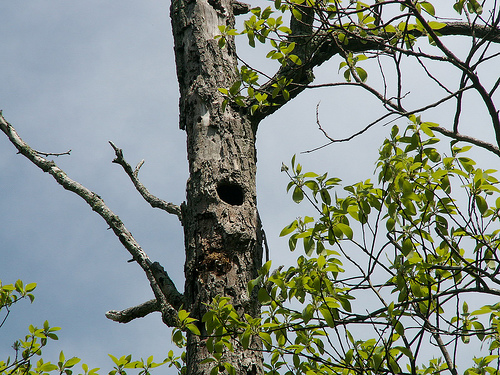Competition is the name of the game in our woodlands. Trees are competing against each other for nutrients. Wildlife are competing for food. Our own desires for our woods can compete against each other. However, you will most likely want to get a variety of things out of your woods (firewood, wildlife, recreation). Understanding what different trees can offer will help you balance all your management decisions. Let’s start by visiting the idea of what makes a good wildlife tree.
In a previous entry, we talked about four wildlife needs: food, shelter, water and space. Trees can help fill two of those needs: food and shelter. There is some planning that needs to happen before you are standing in your woodlot with a chainsaw in hand, trying to decide which trees will keep your house warm and which trees will keep the wildlife warm. Almost every tree in the forest provides something for wildlife, so it is good to know which wildlife you are interested in managing for. Turkey, grouse, deer, songbirds and bear all have different things they are looking for in a tree.
Let’s explore the food aspect. Living trees can provide wildlife with food through buds, seeds, nuts and more. While dead and dying trees attract fungi and insects that are another source of food. Some wildlife feed on some very specific food sources, while others will generally eat whatever is available. Still, wildlife have preferences, and you are better off if you feed their greatest desires.
Although turkey are opportunistic feeders, they prefer oak acorns in the fall. Grouse depend on older aspen stands for feeding on the buds in the winter. A fox squirrel’s favorite food is walnuts and hickory nuts. On the other hand, a variety of woodpeckers, nuthatches and chickadees depend on dead and dying trees for the food sources found in the tree. Overall, wildlife are generally opportunistic, feeding on whatever plants, insects and animals are available. Trees as a source of food are probably not as much of a limiting factor. Still, wildlife have preferences, and you are better off if you feed their greatest desires. If you are considering planting trees for food sources, the Wisconsin DNR offers several different wildlife packages specifically for attracting turkey, deer, grouse and songbirds.
When we talk about trees as a source of shelter, in some cases we are talking about individual trees, and in other cases we need to look at an entire property and the surrounding landscape. If you are interested in grouse, you may need to consider your woods as a whole, and possibly surrounding properties. Grouse prefer several stages of aspen forests, from very young aspen stands for brood habitat to mature stands for mating. Spruce stands provide some of the best winter cover for songbirds and rabbits, and nesting cover for songbirds in spring.
For older trees, dying trees, dead trees (snags) and downed trees, they are more important as individual trees. You will want to consider leaving both hard and soft trees to become snags. Hard trees (such as sugar maple, elm and white oak) don’t decay as quickly, and are good as den trees. Soft trees (such as aspen and birch) are perfect for insect feeding animals.
The larger the tree, the more variety of wildlife can use it, and it can attract larger animals. If you are interested in bear, porcupine, squirrels and insect eating birds, leave more trees to become snags in the interior of your woods. On the other hand, hawks and owls prefer the snags on the edge of woodland for use as lookouts in the search for food. The simplest advice is to leave 1-6 dead or dying trees (snags) per acre.
Start your management for wildlife by identifying what wildlife you are specifically interested in, and making sure that any cutting you do leaves the food and shelter needed for those animals. The food trees will depend on the animals, but there are general recommendations for snags. Leave 1-6 hard snags per acre, even more soft snags, and 4-5 den trees (living trees over 18 inches in diameter at breast height) per 20 acres. Finally, leave a few dead trees on the ground as den trees. Many of these actions can coincide well with whatever else you are managing your forest for.
